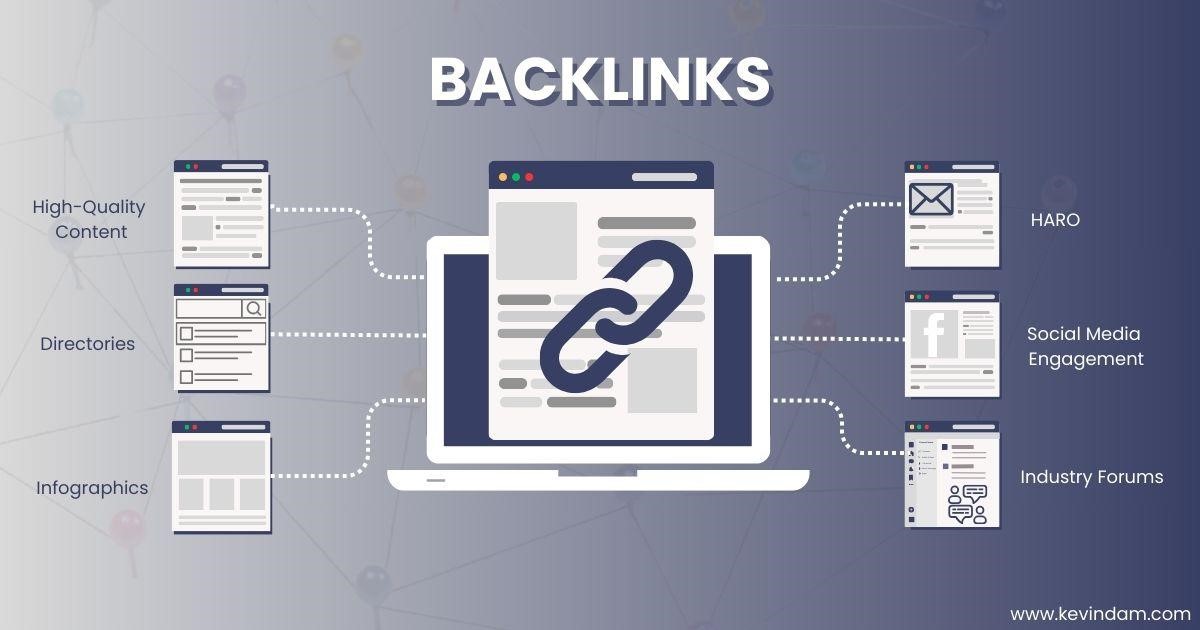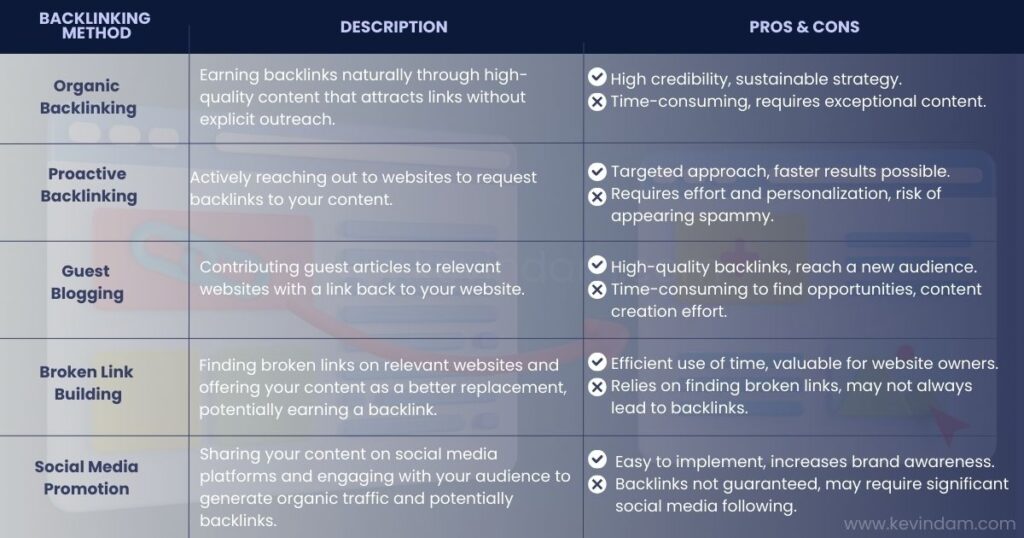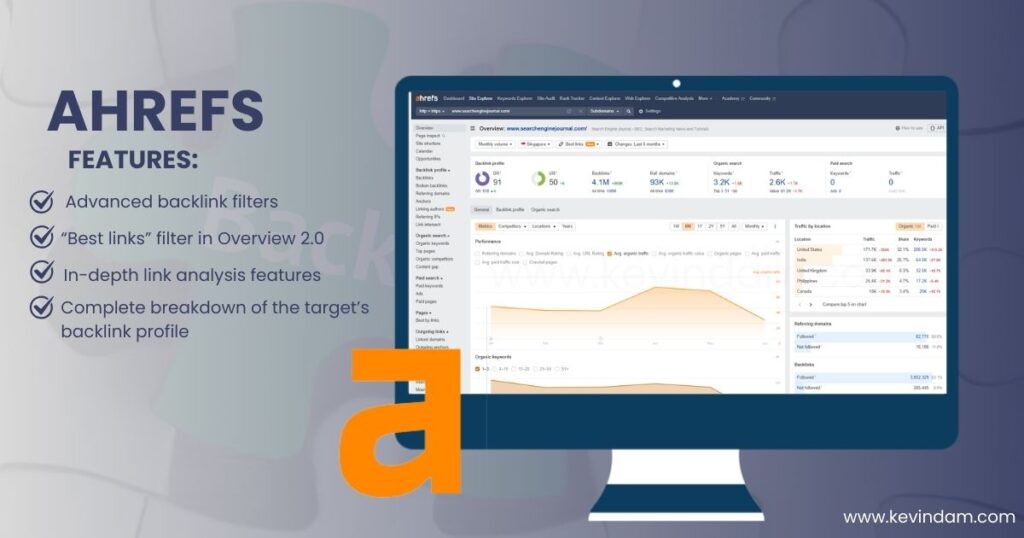
Last Updated August 24, 2024
9 Best Backlink Strategies in SEO: Higher Website Rankings
Building high-quality backlinks is one of the most effective SEO strategies if you want to enhance your website’s search engine rankings and drive more organic traffic. But how do you uncover them ethically and effectively?
This comprehensive guide will dive into the nine best backlink strategies to help take your SEO to the next level. A powerful backlink strategy involves creating high-quality, linkable assets such as in-depth guides, research studies, and infographics that naturally attract backlinks from other websites. Pursuing guest posting opportunities on reputable websites and building relationships with industry influencers can also help acquire valuable backlinks.
Comprehensive Backlink Methods

A comprehensive backlink strategy is not just about acquiring as many links as possible—it’s about creating a diverse and robust network of quality backlinks that signal to search engines the credibility and authority of your website.
It requires a multi-faceted approach to gain inbound links from reliable sources. Let’s dive into the key components of a comprehensive backlink strategy that can elevate your website’s online visibility and rankings.
Organic Backlinking
Organic backlinks are essentially the good word travelling about your content, and they’re far more valuable to your website ranking than you might think.
We’re not talking about paid or sponsored links here; no, these are the real deal—backlinks that come to you naturally because others find your content useful and worth sharing.
But how do you get them naturally?
It involves creating content that stands out, like an inspiring guide, intriguing studies, or compelling infographics that others in your niche want to share with their audience.
Let’s say you write an incredibly insightful guide on fireplace maintenance. People who have a home with a fireplace find this guide extremely helpful and relevant. They share it with their friends or followers and mention it in their article as a reference. That’s where the magic happens—it’s a natural link popping up, pointing users back to your website.
This kind of natural backlink drives traffic and signals to search engines that your website is authoritative within its niche. It’s like building your site’s reputation one share at a time. When other credible and relevant websites say, “Hey, check this out!” about your content, search engines pay attention.
But how do you get this natural flow of backlinks coming your way?
One way is by creating linkable assets—materials so compelling other websites just can’t help but link to them. Things like in-depth expert guides, informative blog posts, or visually appealing infographics can become these sought-after assets that organically attract backlinks.
Let’s take a data-driven study, for example. Conduct research relevant to your industry and present the findings visually appealing. Other professionals and experts in your field may find it incredibly valuable for their work and feel compelled to reference it on their sites.
It’s like getting recognised for being at the top of your game—you’ve put out something so valuable that others naturally want to share it with their audience. When they do, this boosts the visibility and authority of your website and builds genuine connections within your industry—a win-win situation.
Investing in organic backlinking is like nurturing a garden; it takes time and effort to cultivate an environment where natural growth occurs. Now, let’s shift our focus to proactive backlinking strategies.
Proactive Backlinking
Proactive backlinking involves taking matters into your own hands. Instead of waiting for others to discover and link to your website, you actively seek opportunities to secure those valuable backlinks. This can be achieved through various techniques that put you in the driver’s seat, allowing you to guide the course of your website’s backlink acquisition.
Resource Page Link Building
One method involves submitting your website to relevant resource pages. These pages curate lists of valuable resources within specific niches, making them an excellent opportunity for securing targeted backlinks. Submitting your website to these resource pages increases the chances of gaining high-quality backlinks that direct engaged users to your content.
Link Insertion
Another proactive approach is reaching out to site owners for inclusion. If you come across a website or article where your content would serve as a valuable addition, don’t hesitate to contact the site owner or author and propose its inclusion. Demonstrating the value your content adds increases the likelihood of acquiring valuable backlinks that drive traffic and enhance your website’s credibility.
Broken Link Building
Engaging in broken link building presents a proactive opportunity to secure backlinks. By identifying broken links on websites within your niche and offering alternative resources as replacements, you assist site owners in maintaining their content quality and position themselves for potential backlink acquisition.
| Proactive Backlinking Methods | Description |
| Submitting to Relevant Resource Pages | Increase the chances of gaining targeted backlinks |
| Reaching Out to Site Owners for Inclusion | Propose your content for inclusion in relevant articles |
| Broken Link Building | Offer alternative resources as replacements for broken links |
Integrating these strategies into your backlink-building efforts allows you to effectively control how others perceive and connect with your website. This level of influence over your backlink profile is crucial in positioning yourself as a credible and authoritative source within your niche.
So, by actively implementing proactive backlinking strategies, you are expanding your website’s reach and taking charge of its online authority and reputation.
Diversified Backlink Sources
Backlinking is not just about the number of links but also the quality and diversity of sources. Imagine a garden with various flowers and plants – each adds to the beauty and makes it more appealing. Similarly, backlinks from diverse sources add richness and depth to your website’s online presence.
We should aim to acquire links from various domains, including industry-specific blogs, news outlets, educational institutions, and reputable directories. When you have a mix of these different types of websites linking back to yours, it shows search engines that your content is relevant and authoritative across multiple disciplines.
By drawing links from different websites, you demonstrate that experts in various fields respect your content. Just like earning a recommendation letter from a diverse panel of professionals enhances your credibility, having backlinks from different kinds of websites reinforces your website’s standing as an authoritative source of information.
For instance, if your website sells fitness products, having backlinks from renowned fitness blogs, academic journals on health and wellness, and business directories within the fitness industry can significantly boost your site’s trustworthiness in the eyes of search engines.
We aim for a well-rounded portfolio of references, similar to how scholars would bolster their research papers with citations from various reputable publications.
Nowadays, search engine algorithms are smart enough to recognise the significance of diverse sources. They understand that authentic and relevant content attracts attention from various platforms. By diversifying backlink sources, you are harmonising the website’s relevance across different domains – promoting visibility and authority in the digital realm.
Link Building through Outreach

Link building through outreach is analogous to making connections in a big city. Just like you need to network and make genuine connections, online outreach involves reaching out to other websites, influencers, and industry leaders to secure backlinks to your website. It’s saying, “Hey, we’ve got something valuable here. Would you mind sharing it with your audience?”
When reaching out, it’s crucial to remember that we should never pester or pressure anyone. It’s about creating genuine relationships where everyone benefits.
For instance, imagine running a website about sustainable living practises and coming across another website with an article about eco-friendly home products. We might say, “Hey, we love what you’re doing. We also have some great content on sustainable living practises that could complement your article nicely. How about we link to each other’s content?” This approach emphasises finding common ground and mutual benefits.
It’s important to note that personalised and compelling pitches are key in this process. Imagine receiving an email from someone who doesn’t know what your website is about; it doesn’t make you want to help them. This is where showcasing the value your website offers comes into play. If our content aligns closely with theirs and provides additional or complementary insights, it’s important to highlight these aspects.
Reaching out for backlinks is like attending a party and conversing with someone new. We can’t just walk up and say, “Give me something,” right? We must be thoughtful, engaging, and genuinely interested in what the other person has to offer.
A successful outreach strategy requires us to find relevant websites, gather their email addresses and prepare well-thought-out pitches tailored to their needs. By demonstrating how our content adds value to theirs, we create the foundation for a mutually beneficial relationship.
Effective link-building outreach demands time, effort, and finesse – but the results can lead to natural backlink acquisitions and potential collaborations that can elevate our website’s visibility and authority within the digital landscape.
Now that we’ve explored effective strategies for acquiring backlinks let’s turn our attention to the guidelines to ensure the quality of these valuable linkages.
Quality Backlink Guidelines
Quality backlinks are like valuable connexions from authoritative sources to our website. We value genuine, reliable connections in our professional and personal lives. These connections significantly impact websites’ authority and influence in the digital landscape.
So, how can we ensure we’re obtaining these high-quality backlinks?
Let’s break it down.
First, it’s about evaluating the potential linking domains – the websites linking to yours. This involves considering their authority, relevance, and trustworthiness. Are they a known, trustworthy source in their niche? Do they produce content that’s relevant to ours? Is their website reputable and respected by search engines?
We must also avoid link schemes and manipulative tactics that violate search engine guidelines. These unethical practices may provide short-term gains but can result in penalties that harm our website’s rankings and credibility in the long run.
A popular unethical practice is buying or exchanging links with other websites solely to boost rankings. This is a big no-no and can lead to severe consequences from search engines. It’s just like trying to buy your way into an exclusive club – sure, you might get in for a night, but if you get caught, you could face consequences.
Instead of engaging in such dubious activities, we should aim to attract natural, editorially-given backlinks. These are the kinds of backlinks that genuinely arise because other website owners value our content and want to share it with their audience.
It’s important to remember that search engines are getting smarter at detecting unnatural link patterns, and they reward websites that prioritise building relationships and creating engaging, high-quality content that people naturally want to link to.
Think of it as giving a presentation or writing an article that is so compelling and well-researched that others want to reference it when discussing similar topics. When this happens, we’re not just gaining a backlink; we’re also receiving recognition for providing valuable, authoritative information.
As Bill Gates said, “Content is king.” Building quality content is the foundation upon which reputable backlinks can naturally form.
By understanding these guidelines for quality backlinks, we’re setting ourselves up for sustainable and effective backlink strategies.
The next step is to explore various strategies for obtaining high-quality backlinks to put these essential guidelines into practice effectively.
Integrating Backlink Strategy into Content
Crafting compelling content that earns valuable backlinks isn’t just about assembling paragraphs and sentences. It requires a strategic approach that aligns with the interests and needs of your target audience. The goal is to produce content so engaging and valuable that other websites can’t resist referencing it. This process starts with thorough research.
Competitor research is an essential first step in integrating backlink strategy into content creation. By analysing the backlink profiles of popular sites within your niche, you can gain valuable insights into the type of content that attracts high-quality backlinks. This helps in understanding what works well in your industry and identifying opportunities for natural backlink acquisition.
Crafting content with the potential for natural backlink acquisition involves presenting unique perspectives while addressing relevant industry topics. The aim is to create content that stands out, offering valuable insights, in-depth analysis, or innovative solutions to common industry challenges.
For instance, if you notice several high-authority websites linking to informative “how-to” guides within your industry, consider creating a comprehensive and visually appealing guide that offers even more detailed and practical advice. This type of content naturally draws attention and can organically attract backlinks from reputable sources.
Creating original and engaging content, leveraging data-driven insights and incorporating visual elements such as infographics or videos can also enhance the shareability and linkworthiness of your content. Visual information is often highly shareable and can attract backlinks when other websites find value in referencing or embedding these resources.
Crafting shareable content for backlink acquisition is like producing a hit song. Just as musicians strive to create captivating melodies that resonate with their audience, content creators need to produce compelling material that captures the attention of their target audience and provides value worth sharing.
Integrating natural backlink opportunities into the content creation process is vital for a successful strategy. By focusing on producing valuable, shareable, and authoritative content that addresses the needs of your audience while standing out in your industry, you can attract high-quality backlinks organically and boost your website’s visibility and authority.
Tools for Finding Quality Backlinks
As we venture further into maximising backlinks’ potential, let’s explore essential tools for finding quality backlinks.
Having the right tools at your disposal can significantly impact the success of your backlink strategy. Here’s a look at some of the top tools that can help you find quality backlinks and refine your approach to link building, ultimately contributing to improved SEO performance.
1. SEMrush
SEMrush is a comprehensive tool offering valuable insights into the backlink profiles of your top competitors in the niche. It provides high-quality backlink data and enables you to monitor backlinks and campaigns effectively.It includes an outreach tool that can facilitate collaboration opportunities and assist in identifying relevant linking domains. With its detailed analytics, SEMrush provides actionable data to inform and refine your backlink strategy, ultimately contributing to enhanced SEO performance.
2. Ahrefs
Ahrefs helps you discover backlinks pointing to any website or webpage. This includes both your own site and your competitors. Ahrefs boasts a massive database of backlinks, allowing you to see a comprehensive profile.
Ahrefs can also help in analysing backlink quality. Not all backlinks are created equal. Ahrefs goes beyond simply counting backlinks; it analyses their quality using metrics like Domain Rating (DR), which estimates a website’s overall strength based on its backlinks. You can also see if backlinks are “dofollow” or “nofollow.” Search engines consider dofollow links more for ranking purposes.
It can also reveal competitors’ backlink strategies. By uncovering your competitor’s backlinks, you can see which websites are linking to them and why. This can give you insights into their SEO strategy and help you identify link-building opportunities for yourself.
3. Postifluence
Postifluence is another invaluable platform for organic link-building strategies. It also facilitates guest post outreach through its marketplace, making it easier to connect with potential collaborators and build authentic backlinks.
Utilising Postifluence helps you gain access to actionable data that informs your backlink strategy, empowering you to make informed decisions that contribute to improved SEO performance.
These tools not only streamline the process of identifying potential collaboration opportunities but also provide essential insights into effective link-building techniques. They offer valuable data that can be used to refine strategies for optimal results, ensuring that your backlink efforts are focused and impactful.
With the help of these powerful tools, establishing and maintaining a robust backlink profile becomes a strategic advantage in improving website rankings and enhancing overall SEO performance.
Conclusion
A strong backlink strategy is crucial to boost your website’s SEO and attract more visitors. Establish credibility by using high-quality diverse backlinks through organic link-building, outreach, and industry tools. Valuable content naturally attracts backlinks, while proactive efforts ensure growth and visibility. Implement these tactics for better site performance and long-term digital marketing success.



